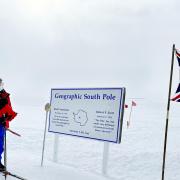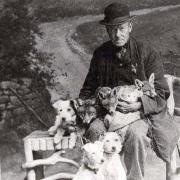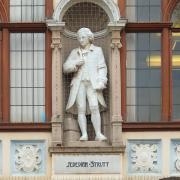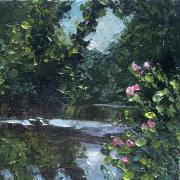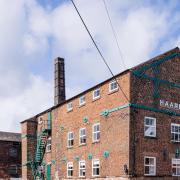Meet the Derbyshire grandfather who has devoted the last 15 years of life to the ancient rural pastime of hedge-laying to help reverse the decline of one of the nation’s most precious habitats for wildlife

As the summer drifts gently into autumn, there are few more quintessentially English traditions at this time of year than rummaging in hedgerows to forage for juicy wild blackberries – before dashing to the kitchen to prepare tasty treats, preserves and puddings to enjoy.
Childhood memories of harvesting the succulent hedgerow fruit whilst wandering in lanes, woods and fields during hazy summer evening walks with family will be a happy recollection experienced by most families.
In addition to providing the county’s jam-makers with some of the most seasonally-delicious fruit, the traditional English hedgerow serves as an impenetrable stock-proof barrier to safeguard, protect and shelter sheep and cattle – and with skilled, regular management and trimming these natural, living fences can last for generations. Hedgerows also provide unique habitats for many of the nation’s most endangered species, including hundreds of plants, insects, birds and small mammals.
In recent times, hedgerows have faced numerous challenges, risks and threats for survival – with many facing destruction and removal, resulting in the loss of thousands of miles of precious, irreplaceable hedges and hedgerow trees.

According to the Woodland Trust, the UK’s leading woodland conservation charity, an estimated half of all hedgerows were lost from the countryside in the last century – the vast majority due to agricultural intensification between the 1940s and the 1970s.
Staggeringly, the 2007 Countryside Survey of Great Britain painted a darker picture for the future of the British hedgerow, reporting that the length of hedgerows declined by over six per cent between 1998 and 2007, and ‘only 48 per cent that remained was in good structural condition.’ Furthermore, an Institute of Terrestrial Ecology survey of hedgerow changes has revealed that: ‘between 1984 and 1990 hedgerow length in England had declined by 20 per cent.’
The Royal Society for the Protection of Birds (RSPB) has said that since the end of the Second World War, hedgerows have also been removed at a much faster rate than they have been planted. The RSPB claims: ‘In some parts of the country 50 per cent of hedgerows have gone, while others are so badly managed that their value to wildlife is much reduced. Loss of hedgerows has been identified as a factor in the decline of many plant and animal species traditionally associated with farmland.’ The charity argues that the reasons for hedge loss included changes to farming practices, development, damage caused by straw and stubble burning, chemical spraying, neglect and indiscriminate trimming.
The destruction of the nation’s hedgerows has hit our wildlife hard – as they can if well maintained provide food and shelter for numerous species. The RSPB states: ‘Hedges may support up to 80 per cent of our woodland birds, 50 per cent of our mammals and 30 per cent of our butterflies. The ditches and banks associated with hedgerows provide habitat for frogs, toads, newts and reptiles. In areas with few woods, many species of birds depend on hedgerows for their survival. At least 30 per cent nest in hedgerows.’ These birds include bullfinches, turtledoves, whitethroats, linnets and yellowhammers.

The arrival of Dutch elm disease to Britain in the 1960s had a significant impact on hedgerow cover, as the English elm was a significant hedgerow tree. It is estimated that over 25 million trees died in Britain during this period. According to the Woodland Trust tree coverage in Derbyshire has not recovered since this time – with just 8.8 per cent tree cover in the county, compared to the English average of 10 per cent.
For one Derbyshire man, this decline of Britain’s hedgerows and hedgerow trees is a tragedy – and he has devoted the last 15 years of his life to help improve hedgerow cover throughout the county.
Derrick Hale from Littleover, near Derby, is committed to reversing this trend and now spends most of his autumn and winter months out in the countryside hedge-laying. Working in remote areas of the county, often on his own and in all weathers, Derrick is committed to restoring Britain’s hedgerow heritage. He serves as the media officer for the National Hedgelaying Society and takes part in numerous competitions throughout the hedge-laying season.
‘In Derbyshire we have some of the finest hedgerows in England – with many ancient examples dating back to the Enclosure Act of 1773, which enabled rich landowners to enclose land and remove the right of commoners to access the area,’ explains Derrick.
Between 1720 and 1840 hundreds of smaller enclosure acts were passed by Parliament, resulting in the creation of over 200,000 miles of new hedges throughout Britain. ‘Although the acts were greeted almost universally negatively, the legislation had an unexpected benefit for the landscape and wildlife. During this time, thousands of miles of new hedges were planted – all providing shade, shelter and protection for livestock. The newly created hedgerows also helped to act as windbreaks, reducing soil erosion and providing habitats for hundreds of birds, mammals and insects,’ he recalls.
‘The environmental benefits of hedges are still as positive and strong today. A competent hedge-layer will often see birds and small mammals moving in to a newly created hedge before he has time to pack away his tools at the end of a day of hedge-laying,’ Derrick says proudly. ‘In springtime these species will nest in the hedges – safe and secure from predators such as magpies. In autumn small mammals, including hedgehogs, will hibernate in the shelter and comfort of the dense structure.’
‘I’ve always been interested in nature and the countryside,’ he explains. ‘My love of the outdoors goes back to childhood; although farming had died out of my family two generations before me, I still kept in touch with the countryside with my parents – and by the time I was old enough I was always outside.’
His passion for hedge-laying is a distant cry from his professional career, teaching psychiatric nursing to students at the Derby School of Nursing. ‘I worked for the NHS for many years, before taking the opportunity for an early retirement,’ says the grandfather of four. ‘I always loved the countryside and wanted to do something to improve and enhance the Derbyshire landscape. One day I was driving home when I noticed a large number of gaps in hedgerows – often plugged with post and rail fences – and this worried me. I wanted to do something about this; so I decided to become involved in hedgerow planting.’
Within weeks Derrick had registered to do a hedge-laying course with the Brailsford and District Ploughing and Hedgecutting Society. ‘I really enjoyed it – and the rest is now history,’ he laughs. ‘Whilst on the course I was fortunate to be introduced to several of Derbyshire’s most experienced and talented hedge-layers – many of whom were national champions in the country craft. The tutors on the course were well-known hedge-layers including Anthony Archer and the late Brian Goodhall – the first man I saw using an axe with, to me at the time, amazing power and accuracy.’
‘I was also fortunate to meet Geoff Key later that year during the society’s annual competition. Geoff was extremely generous with his time – I tested his patience (and I know I still do) but his tuition was wonderful,’ remembers Derrick.
‘Hedgerows don’t look nice by accident,’ smiles Derrick. ‘Hedges need to be well maintained, thick and strong. If hedges are not properly cared for they will grow tall and gappy – and will eventually decay. There are dozens of styles of hedge-laying, most serving the objective of keeping livestock in the correct space or field. The Derbyshire style of hedge-laying is particularly good for keeping sheep and cattle in their rightful place.’
Derrick believes that Derbyshire is fortunate to have some of the most skilled and talented hedge-layers in the country. ‘Many of our county’s best-known hedge-layers have demonstrated the Derbyshire style at national tournaments and have been very successful, including people such as Steven Leslie, John Walker and Stuart Archer – many of whom have been supreme national champions in the National Hedgelaying Society Championships,’ he recalls. ‘This year’s national championships will be held in Chew Valley Lake, near Bristol, on 24th October. We’ve got an excellent chance of bringing silverware back to Derbyshire!’
Derrick’s partner Ros is very encouraging of his interest in conservation and regularly attends competitions to lend her support. ‘Ros is a great advocate of hedge-laying; it is a very social pursuit and she loves to come along to events and meetings to chat with other wives and partners,’ explains Derrick. ‘Ros always looks forward to seeing the transformation that takes place within the course of a hedge-laying match – the view across the countryside is changed and the hedge turned into a work of art!’
He is keen for others to follow in his footsteps and welcomes newcomers to join in and discover the country craft. ‘For many people, living in Derbyshire, hedge-laying will only become obvious along roadsides towards the end of the season – before the new growth stimulated by the hedge-laying obscures the work later in the year,’ explains Derrick. ‘A good hedge-layer needs an “eye” for detail and for the work in order to see exactly where each branch and even each twig will best fit into place. An ability to think and to work in three dimensions is important – in a nutshell, good spatial awareness! A good level of physical fitness is also needed – hedge-laying is hard work and requires strength and the ability to handle tools to lift and lower heavy timber into place. A full body workout is guaranteed!’
Derrick is excited about the future for hedge-laying in Derbyshire – and he believes the country pursuit is becoming very popular. ‘After the BBC Countryfile programme reported on hedge-laying in the grounds of the Princes of Wales’s Highgrove Estate in 2013, we have seen new people showing an interest in the craft,’ he says. ‘And this year’s Brailsford and District Ploughing and Hedgecutting Society event will have The Princess Royal in attendance.’
For more details on Brailsford Ploughing Match visit www.brailsfordploughingmatch.org.uk








